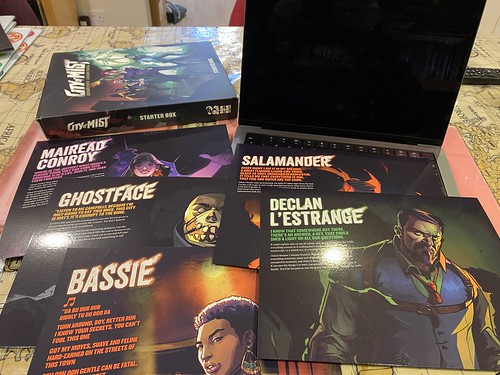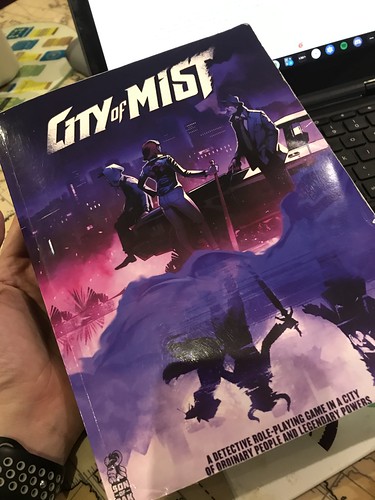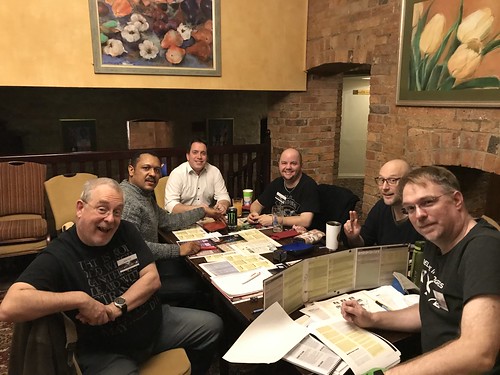 |
| An epic campaign for City of Mist |
Nights of Payne Town came from the kickstarter campaign that Son of Oak ran to create a story arc for their City of Mist roleplaying game and to also sort out their finances for the stretch goals of the original Kickstarter. It is presented as a 294-page full-colour hardback book, gorgeously illustrated and nearly typo-free. Layout and design are clear and help the reader quickly identify information through the use of colour (for example: key clues are highlighted in yellow, story arc clues in a purple).
TL;DR: Nights of Payne Town is a well produced sourcebook for City of Mist with gorgeous production values and an epic story are. It's complex, but well supported, with enough flex in the cases and writing to allow for the players taking different sides and approaches to heal the Fisher King's pain. Recommended.
The campaign is presented in three distinct veins, each of three cases (scenarios). There are interlinks between the veins, but it's recommended to run them in sequence. There's also an over-arching case in three acts which draws the whole story-arc together, triggering at the climax of each vein.
The main plot revolves around the Arthurian Myths, in particular the Fisher King and Holy Grail. However, the cases also link back to the deep background of the City. There's a lot to unpack, and I suspect you may well want to interweave in some cases unrelated to the campaign if you wanted to get the most out of it.
The three veins are the Personal vein, the Mystical vein and the Criminal vein. Each has reoccurring themes; Broken Glass, Alchemical Transformation and Arthur/Camelot. The climax of each vein involves a major villain - Grail Knight - and they're typically very dangerous and broken because of a failed interaction with the Grail.
The first case in the Personal vein is 'Killing Her Softly'. The crew get drawn into an investigation to find a killer threatening the jazz and blues singer Martha Ellis. I've run this scenario at one of the Garricons; it works well, but the clues to the deeper levels of the mystery need to be carefully brought in to avoid it feeling too directed. Once they're in play, the case gathers momentum and moves towards a potentially lethal denouement.
'Carnival of Death' is the second adventure in the Personal vein. It starts off by throwing the crew into a suspicious death in a love triangle, but twists into a macabre carnival of horrors which could be brutal if approached incorrectly. I think I'd be wary of running this early in the campaign because it relies upon a good understanding of each Rift's motivation and history. I think that it would be more effective to get a number of scenarios under the crew's belt to make this work well. It's also worth noting that the carnival itself relies on a lot of improvisation based on the MC's understanding of each Rift's background and drives. An intriguing plot, but l'm not sure how well it would land in reality, shifting from neo-noir detective to horror; I fear it could feel quite disjointed.
The Personal vein ends with 'Broken Glass', a scenario which places the City in peril from the actions of one of the Grail Knights. This investigation brings the characters directly in the line of fire from the person responsible for the previous two scenarios. It's likely that they won't be able to defeat the villain unless they're willing to make sacrifices that will change them forever. However, they will learn important clues to the overall plot that links all the scenarios. I like this scenario - it feels climatic and dangerous, and will need some clever thought to succeed without the risk of significant loss.
The next vein is the Mystical one. The vein starts with 'The Furnace', another case which I've run at a Garricon. It focuses around drugs which only affect Rifts, and an investigation into missing persons. It's quite a dark case, and the potential exists for the characters to lose hard if they mess up. That said, a bit of ingenuity from the players will solve this; it certainly did when I ran it. The case also gives a glimpse into more active elements of Rift society, perhaps offering a vision of what life can be if the crew members more fully embrace their nature. The location in the case also links back to the Personal vein, although this may not immediately be apparent.
The second case in the vein is 'The Cult of the God-King', which was a new scenario for me. The scenario very rapidly moves away from the more classic noir detective style, reminding me strongly of some weirder aspects of the Marvel Netflix Daredevil and Iron Fist series. This is a more complex scenario, and the MC will need to think and develop on their feet. That said, the key scenes are all there. The case links back to the Furnace and provides clear threads beyond to pull on. Indeed, the Mythos of Ariadne can become an ally for the crew if they play things right. This is a potentially deadly and messy investigation into a secretive cult. Perhaps the only saving grace for the crew is that the cult does want to remain in the shadows; that said, they won't hesitate to use deadly force.
As an aside, it's worth noting that every case has an ' 'aftermath' section which asks questions about the outcome. This is really useful - it helps the MC consider how the present scenario may affect the future ones. It also gives hooks to add in further cases or events. The space for reflection is a good thing.
The final case in the Mystical thread is 'The Alchemist'. Once again, it focuses upon one of the Grail Knights, Armand Kai. Kai embodies the themes of transformation throughout this vein. He is a master alchemist, trying to find a way to cheat death having crossed paths with the Fisher King. The case is described as either a cinematic dungeon-crawl or a heist. Frustratingly, there is a set of heist rules referred to from the PDF supplement 'Fortune Row' which aren't reproduced here. I think I'd prefer to use a heist style approach here as the location is absolutely brutal. It will be hard to come through this without your Rift being transformed in some way; that is the theme of the case and vein, but it would also be very easy for this to be catastrophic potentially ending their involvement in the ongoing campaign. The MC will need to think about this carefully when preparing to run this; it's dangerous, magical and transformational.
Overall, this vein very strongly brings on its themes of transformation and alchemy. it feels magical and dangerous, reminiscent of some parts of the Netflix Marvel Daredevil & Iron Fist series when they engaged with 'The Hand'. I think I would probably interspace this with the other veins or it could be overwhelming and quickly push away from the noir aspects of City of Mist which drew me into the game in the first place.
The final vein is the Criminal vein, which opens with 'Albion Awakens'. This vein is a direct counter-point to the Fisher King myth at the heart of the campaign.
The case is an investigation into a new biker gang which has been taking over the streets of the White diff District. The crew will become involved in the rise of the Rift of King Arthur, and will be able to chose between supporting or opposing his establishment of a power base to oppose his enemy. This is an ongoing conflict between Arthur and the Fisher King, twisted by the Dolorous Stroke. The case steadily escalates as the Arthurian myth exerts itself in a conflict to control the city. I like this case; it blends myth and noir well, working together and resonating. It feels a more natural fit with the theme of the game than some of the other cases.
The Criminal vein continues in 'Home is where the heart is'. This case puts the crew investigating a real estate corporation which is devouring the local neighbourhood. They've done it before, elsewhere, and the methods were the same. People leave, businesses fail, intimidation is rumoured. The crew have plenty to investigate, and the trail will lead them towards the dark and dangerous horror at the heart of the case. I like this scenario - it'd also work well as a standalone game for a convention - and it's a good second case for the vein. The only thing to be aware of is that there's a good possbility that the end of this case triggers the next, final case in the vein immediately.
The final case in this sequence, 'The Streets Bleed Neon' brings the Criminal vein to a close. This case feels apocalyptic as the Rift of King Arthur makes a flawed attempt to forge a superweapon to enable him to directly assault the Fisher King. The problem is that the power's unleashed threaten the city and the Mist itself. The case takes the form of loosely linked scenes; depending upon the choices the crew take, they could be on either side, and perhaps change their mind along the way. The events and outcome are the clearest link to Fisher King, and may help to reveal the heart of what is going on. Unlike the other Grail Knights, Arthur is actively working against the Fisher King and unaware that he unwittingly supports his aims.
The final section of the book is the overarching case, 'Percival'. This is a case in three parts, each one triggered by completing the final scenario in a vein. The revelations from each of these unlock secrets about the Fisher King and the potential to encounter him. Ultimately, these secrets are the elements which will allow the crew to solve the story arc and save the City.
Reflecting on working my way through the cases, I'd like to run this if I can find the players who would want to commit the time to it. I've run at least three of the cases standalone and they worked well. I do think that the campaign as a whole needs some work to get the best out of it, but all the bones are there. It's strongly written and in my mind's eye I can imagine this as a Netflix Marvel style series. I think I'd start with some other cases to ground the crew (perhaps from the starter set, but that would leave certain threads unresolved).
In summary, Nights of Payne Town is a well produced sourcebook with gorgeous production values and an epic story are. It's complex, but well supported, with enough flex in the cases and writing to allow for the players taking different sides and approaches to heal the Fisher King's pain.
Recommended.
15 August 2022












